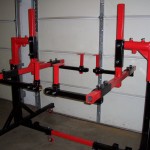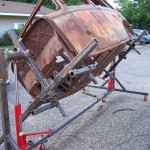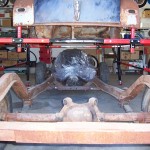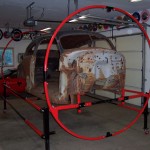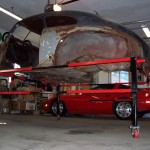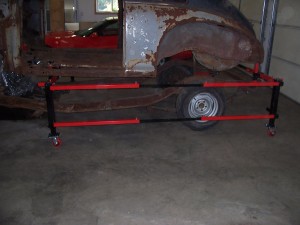These are the notes that come with the plans.
These building notes are put together as guidelines and are placed in no particular order of importance. I would suggest reading through them before starting the project. I would also recommend reading through the instruction manual as well. That will give you a better idea of the project and how it works as an end result.
The body lift & roller is made up of 8 different main parts and many different pieces to make up the main parts. The main part names are as follows: Legs, Main beams, Cross braces, Hoops, Hoop connectors, Hoop hook up, Body mount bracket, And Body mount. I have made drawings of all the individual parts as well as the main parts.
All nuts should be welded on at least 3 sides and that is if you are a good welder, if not they should be welded all the way around. It has been my experience that using smaller nuts not only dents the tube you are pressing against but over many uses of the rotisserie the nuts can become stripped out. Not to mention more warping during welding making them hard to use. A quick tip is after welding the nuts, run a tap through the threads after it cools down. This will make life a lot easier for using the unit in the future. Also, unless otherwise stated in the drawings, all nuts to be welded are 1/2”. Most of the parts have both through holes and pinch bolts to hold everything together. The through bolts are for safety and the pinch bolts are for taking the slop out of the mating parts. It is strongly recommended to use both.
The caster plates are a for a standard 6” caster. If you are going to use a different size I would recommend getting the caster first and making the plates to fit your casters.
The .188” thickness is a standard tube size that not only makes the body lift heavy duty but also makes all the tubes slide inside one another quite nicely. I wouldn’t use lighter tube because of strength reasons as well as the amount of slop in between mating parts.
You will notice in the prints that I call out some weird hole sizes. I drill all my holes 1/32” bigger than the bolt I use to make life easier down the road. There is nothing wrong with making the holes exact size or 1/16” bigger. It all depends on what drill bits you already have. If I call for a .813” hole and you only have a 3/4” bit by all means use it instead of going out and buying a new bit. If you have a 7/8” bit, use it, you get the idea. If I call for a through hole that means all the way through the other side of the tube.
You will notice on some of the 4 view drawings that some of the views are out of proportion with the others. This is for clarity and to give you the biggest view possible for standard paper from your printer. Please note that drawings are not to scale, so don’t measure off the drawings. there is enough information on each part to build each part. If you have any problems figuring something out, just look at another print that has that part on it or a picture view. This body lift & roller was drawn with common sense in mind, it is not rocket science. If there is something really important I made a note of it on the drawing or building notes page, otherwise it is no big deal.
You will see on the leg internal parts drawings that I use a couple of 3/4” brass flat washers
per leg. This is to reduce friction from the nut turning against the top cap. I used to build the legs without them but I found using them really helps make lifting the unit up and down a lot easier. I would have used plastic washers but they will melt due to the heat from welding the nut on top and the steel flat washer underneath. Also it is a good idea not to sandwich all the washers too tightly against each other. Give them some clearance so everything will work smoothly after welding.
The hoops that are dimensioned on the prints will have an end result diameter of 8’4” tall. It all depends on how long the hoop sections and hoop section splice ends are. Here is the formula for figuring out what size you need with your garage ceiling clearance in mind.
Hoop section = 25” and hoop section splice end = 12.5” an end result of 8’ 4” diameter will occur.
(this is the way the prints were dimensioned)
Hoop section = 23” and hoop section splice end = 11.5” an end result of 7’ 6” diameter will occur.
Hoop section = 21” and hoop section splice end = 10.5” an end result of 7’ diameter will occur.
I hope this isn’t too confusing. The bottom line is: the smaller the hoop parts, the smaller the end diameter will be. The reason I went with 8’4” diameter for the plans is that you will never find a car too big to fit nicely in that size hoop. Conversely, I wouldn’t make my hoops any smaller than 7’ diameter or you will be pretty cramped even with the smallest cars.
You will notice on the plans for the legs I use 3/4” ACME threaded rod and nuts for the telescoping. This is a little harder to come by than regular threaded rod but I’ve tried the regular stuff and I ended up pulling my hair out trying to get it to work properly. Believe me there is a reason that machines with moving parts all use acme thread (lathes, milling machines) they can travel over and over again and the threads still work. Depending on how big of a town you live in you might have to order it. Just search for acme threaded rod on google to find a place to get it. I used to get mine from Williams Steel & Hardware in Minneapolis, MN. Most larger hardware stores will have it or at least order it for you.
In all of my pictures you will notice that the hoops were made of pipe instead of square tubing. This is because I used to build many of these things and it was a real time saver to have pipe rolled to the diameter I wanted and just cut it into quarter sections. Because of the expense in paying someone to roll your hoops, I chose to show it in sections of square tubing that can be welded together. If you have the equipment and/or the ability to roll pipe or tube that would be just fine, but I felt that most people wouldn’t even bother. I know I wouldn’t if I was only going to build one. The only reason I went with pipe instead of square tube was that, the cheapest company to do it could only roll pipe. The concept is the same no matter what material you use.
Let’s talk a minute about the fact that I did not dimension any hoop hook up procedures. All the parts needed are dimensioned. There are way too many variables involved for me to give hard dimensions on the hoop hook up procedure. The fact that I don’t know your garage ceiling height, your car width, not to mention that if all of the hoop sections got cut even 1/4” shorter or longer will drastically change the over all dimensions, is why I did not dimension the procedure. If I did, someone would build all the parts without reading these building notes and then realize that it won’t work. It is a very simple process and it goes as follows:
Once the body lift is built and put together, raise the legs about 6” higher than their lowest position. (Make sure you have the casters installed). Also make sure the body lift is put together at least 7’ wide. (Around 7’ seems to be the best). Next, install the hoop hook up tube to the main beam short tubes sticking out. Then put the fully assembled hoop in front of the lift like the print shows on the hoop hook up instructions page (the hoop should be touching the ground). Once both sides of the hoop is touching the hoop hook up tubes you will want to tack weld them to the hoop. (Tack them in a couple spots so they won’t break off when you remove the hoop from the main beams). Once that is done you can put the hoops on a bench for welding and installing the gusset plate. You now know that once the car is on the body lift and you go to install the hoops, the legs will be able to be lowered all the way, so the hoop is on the ground, and the legs can be taken off. I hope this wasn’t too confusing. You might want to read this again due to my lack of writing ability. I won’t leave you high and dry, so here is my cell phone # Matt Kline I hope you won’t need to call, but just in case, there it is. You can also contact me anytime from my website www.redwingsteelworks.com or .org. Another good reference for this is all the pictures on my website and the instruction manual.






